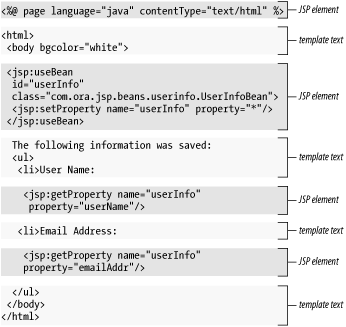JSP Processing
A JSP page is simply a regular web page combining static markup with JSP elements that generates the parts that differ between requests, as shown in Figure 4-7.
 |
Everything in the page that isn’t a JSP element is called template text. Template text can be any text: HTML, WML, XML, or even plain text. When a JSP page request is processed, the static template text and the dynamic content generated by the JSP elements are merged, and the result is sent as the response to the browser.
A web container that supports JSP intercepts all requests for JSP
pages. To process all JSP elements in the page, the container first
turns the JSP page into a servlet (known as the
JSP
page
implementation
class). The
conversion is pretty
straightforward; all template text is converted to println(
) statements similar to the ones in the servlets shown in
Example 4-1 and
Example 4-2,
and all JSP elements are converted to Java code
that implements the corresponding dynamic behavior. The container
then compiles the servlet class.
Converting the JSP page to a servlet and compiling the servlet form the translation phase. The JSP container initiates the translation phase for a page automatically when it receives the first request for the page. The translation phase takes a bit of time, so the first user to request a JSP page notices a slight delay. To avoid ...
Get JavaServer Faces now with the O’Reilly learning platform.
O’Reilly members experience books, live events, courses curated by job role, and more from O’Reilly and nearly 200 top publishers.

